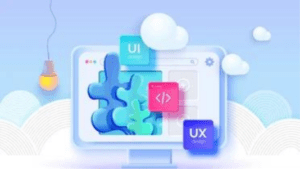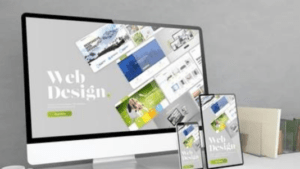Top UI Design Tools for Web Development
- Adobe XD:
Adobe XD is a powerful UI design and prototyping tool that enables designers to create interactive and responsive web interfaces. It offers a range of features such as artboard layout, vector design tools, responsive resizing, and prototyping capabilities. Adobe XD also integrates well with other Adobe Creative Cloud applications, making it a popular choice among designers who already use Adobe software.
- Sketch:
Sketch is a vector-based UI design tool exclusively available for macOS. It is widely used for creating high-fidelity designs and interactive prototypes. Sketch offers an intuitive interface, symbols and styles for efficient design consistency, and various plugins for extending its functionality. It has gained popularity among UI designers due to its ease of use and focus on design collaboration.
- Figma:
Figma is a cloud-based UI design and prototyping tool that enables real-time collaboration among team members. It offers a range of features such as vector editing tools, design components, prototyping capabilities, and design handoff. Figma’s cloud-based nature allows multiple designers to work simultaneously on a project, making it a preferred choice for remote teams and designers who value collaboration.
- InVision Studio:
InVision Studio is a comprehensive UI design and prototyping tool that aims to streamline the entire design-to-development workflow. It provides features like vector editing, animation, responsive design, and collaboration. InVision Studio allows designers to create interactive prototypes with advanced animations and transitions, facilitating effective communication with stakeholders and developers.
- Axure RP:
Axure RP is a prototyping tool that focuses on creating highly interactive and dynamic prototypes for web and mobile applications. It offers an extensive set of features, including conditional logic, variables, dynamic panels, and robust prototyping capabilities. Axure RP is commonly used by UX designers who require advanced interactions and complex user flows in their prototypes.
- Adobe Photoshop:
While primarily known as a raster graphics editor, Adobe Photoshop is also widely used for UI design. Its extensive set of tools and features allows designers to create detailed and visually appealing web interfaces. Photoshop’s integration with other Adobe Creative Cloud applications, such as Adobe XD, facilitates a seamless design workflow for designers who prefer Adobe software.
- Marvel:
Marvel is a user-friendly UI design and prototyping tool that focuses on simplicity and collaboration. It offers a drag-and-drop interface, design libraries, and prototyping capabilities. Marvel’s streamlined workflow makes it easy for designers to create interactive prototypes and share them with stakeholders or clients for feedback and review.
- Zeplin:
Zeplin is a design collaboration and handoff tool that bridges the gap between designers and developers. It allows designers to upload their designs, generate style guides, and share assets with developers. Zeplin streamlines the design-to-development process by providing developers with accurate design specifications, CSS snippets, and image assets, reducing the chances of miscommunication and speeding up development.
- Principle:
Principle is a prototyping tool specifically designed for creating interactive animations and micro-interactions. It offers an intuitive timeline-based interface, allowing designers to create smooth and visually appealing animations without writing code. Principle’s focus on animations makes it an excellent choice for designers who want to add motion and interactivity to their UI designs.
- Webflow:
Webflow is a comprehensive web design and development platform that combines UI design, prototyping, and code generation capabilities. It offers a visual interface for designing web layouts, responsive designs, and interactions, while also providing the flexibility to export clean HTML, CSS, and JavaScript code. Webflow is popular among designers who want to create visually stunning websites without relying on traditional code editors.
- Canva:
Canva is a user-friendly online design tool that caters to both beginners and professionals. It provides a wide range of pre-designed templates, stock images, icons, and fonts, making it easy to create visually appealing web interfaces. While Canva is not specifically designed for UI design, it is a popular choice for quickly creating simple and visually engaging designs.
- Proto.io:
Proto.io is a web-based prototyping tool that allows designers to create interactive prototypes for web and mobile applications. It offers an intuitive drag-and-drop interface, supports animations and transitions, and provides collaboration and feedback features. Proto.io also offers integration with design tools like Sketch and Photoshop, enabling designers to import their designs and enhance them with interactive elements.
- Gravit Designer:
Gravit Designer is a vector-based design tool that offers a range of features for UI design. It provides an intuitive interface, powerful vector editing tools, and the ability to design for multiple screen sizes and resolutions. Gravit Designer’s cross-platform support and its free version make it an accessible choice for designers who want a feature-rich design tool without a hefty price tag.
- Lunacy:
Lunacy is a free graphic design tool specifically designed for Windows users. It supports Sketch file import, allowing designers to work with Sketch designs without needing a Mac. Lunacy offers a familiar interface and many of the essential features required for UI design, making it a viable alternative for designers who prefer the Windows operating system.
- Protopie:
Protopie is an advanced prototyping tool that focuses on creating realistic and interactive prototypes for web and mobile applications. It allows designers to add complex interactions and behaviors using its intuitive interface, making it suitable for designers who want to prototype advanced user experiences. Protopie supports sensor inputs and device-specific interactions, enhancing the realism of the prototypes.
- Conclusion:
The field of UI design for web development is constantly evolving, and there is no shortage of tools available to designers and developers. Each tool mentioned in this article has its unique features and benefits, catering to different design preferences, collaboration needs, and skill levels. Whether you are looking for a comprehensive design and prototyping tool like Adobe XD or Figma, a specialized prototyping tool like Axure RP or Principle, or a design collaboration tool like Zeplin or InVision Studio, there is a UI design tool available to suit your requirements. The key is to explore different tools, experiment with their features, and choose the one that best aligns with your design workflow and project goals.



